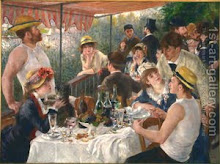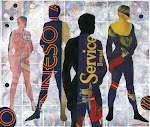TIP: Remember this when starting on a new piece; place the important elements of your work where they are most pleasing to the eye and communicate most efficiently across to the beholder.
The above goal can be accomplished in many ways and one of those is to conform to the rule of thirds. By dividing your piece into nine equally sized rectangles or squares and placing key elements on, or close to some of the focal points and along the lines, you can create a much more eye-pleasing piece of art. The four spots where the lines meet are called focal points where the upper and lower right spots are the most important. This is because most of us were taught to read from left to right, hence it is the most natural way for us to look at an image also. Look at the picture below.
More Composition Styles
There are many other ways to compose an art piece; the L-Composition, the Iconic composition, and the Cross composition just to name a few. They each have their strenghts in communicating across to the viewer. Look at the illustrations below of the three different compositions styles below. By placing important elements on top of or along the lines, or directly on the focal points you can create a more effective work of art.
Returning shortly to the rule of thirds it is important to mention that the focal points do not necessarily need to be covered by solid objects. For instance, if you wish your piece to be spacious you can easily let the area around some of the focal points have alot of surrounding space. Another important thing is to not have important elements on the different focal points in the same artwork competing with eachother over the viewers attention. That way it'll do more harm than good, and break the balance you are trying to achieve in your artwork.
The Final Words (and more composition stuff)
This short tutorial is only meant as a preliminary step into the world of art composition, and a brief reminder that composition is indeed very important. Solid composition can make a mediocre piece look good, and a good one look great. Once you are comfortable with the basics you can even combine different styles of composition but that takes alot of practice to master. The possibilities are pretty much endless. Before the final punctuation of this art tutorial, I want to share a link to one of the best in-depth composition tutorials the web has to offer (well at least in my own humble opinion) The webs best art composition tutorial.
Enjoy!





No comments:
Post a Comment